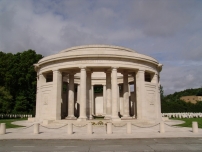| First Name: | Worthy Thomas | Last Name: | WHITE | |
|---|---|---|---|---|
| Date of Death: | 12/04/1918 | Lived/Born In: | Regent's Park | |
| Rank: | Rifleman | Unit: | King's Royal Rifle Corps16 | |
| Memorial Site: | Ploegsteert Memorial, Belgium | |||
Current Information:Born-St Pancras
The second major offensive by the Germans in the Spring of 1918 began on 9th April when they launched Operation Georgette on the seventeen miles of front running between the La Bassée canal and Houplines, just to the north of Armentières. They met with immediate and overwhelming success when in the first few hours they broke clean through the weak 2nd Portuguese Division at Laventie and from there pushed further and further into British territory. The need to contain the German advance was paramount and reinforcements were urgently sent to shore up the defences. 33rd Division was sent south from Second Army at Ypres and detrained at Caestre and Strazeele on 11th April. That evening 100 Brigade took over part of the line from Le Romarin to east of Neuve Église with 16th King’s Royal Rifle Corps on the right. There was little time to acclimatise to their new surroundings. The next morning, 12th April, they found themselves in the thick of the fighting. The enemy attacked behind a fierce artillery barrage and soon gaps appeared along the line held by 100 Brigade. Isolated groups were surrounded and were not seen again but those who were able to, continued the fight and managed to repel some of the German advances. The struggle moved up a gear on 13th April. During a misty morning there was another heavy artillery barrage and the line on the right of 16th King’s Royal Rifle Corps gave way, ‘A’ Company tried to swing back to keep in touch with troops in the rear but it was not possible to get a message to the remaining companies who fought on until they ran out of ammunition and were overrun. ‘A’ Company took up positions in the streets of Neuve Église and a patrol was sent out to try to make contact with 9th Highland Light Infantry, known to be in support nearby, but all they made contact with was the enemy. Completely surrounded they fought their way out of the centre of the village and took up a position on the Dranoutre road .’A’ Company now numbered one officer and twenty men but some stragglers were collected and others arrived back from the more forward companies and with 200 men handed over by 75 Brigade this new position was consolidated despite enfilade fire from machine-guns. Events now moved very rapidly and with battalion HQ out of action there developed a series of isolated fights during which British artillery shells fell short, adding further to the casualty list. During the afternoon a German attack was broken up but the enemy now occupied Neuve Église and once again 16th King’s Royal Rifle Corps were in danger of being surrounded. Neuve Église church now became the centre of resistance with 16th King’s Royal Rifle Corps and other units all mixed up. Things were a little less hectic on 14th April and 100 Brigade were relieved by 49th Division and moved back into support. However their numbers had been so reduced that a weak composite battalion was formed from the remnants of 16th King’s Royal Rifle Corps and 9th Highland Light Infantry. The story did not end there. The German advance continued the next day and once again they found themselves in the front line, this time behind the village of Keersebrom and over the next two days had to withstand more shell fire which further reduced their numbers. It was not until the evening of 17th April that 100 Brigade was finally relieved and moved back from the front line. Among the many casualties sustained by 16th King’s Royal Rifle Corps during this intense period of fighting was Worthy White who was killed on 12th April. |
||||
| « Back to Search Results | ||||
| If you think any of the information shown here is incorrect, Click Here to submit your amends and comments | ||||




